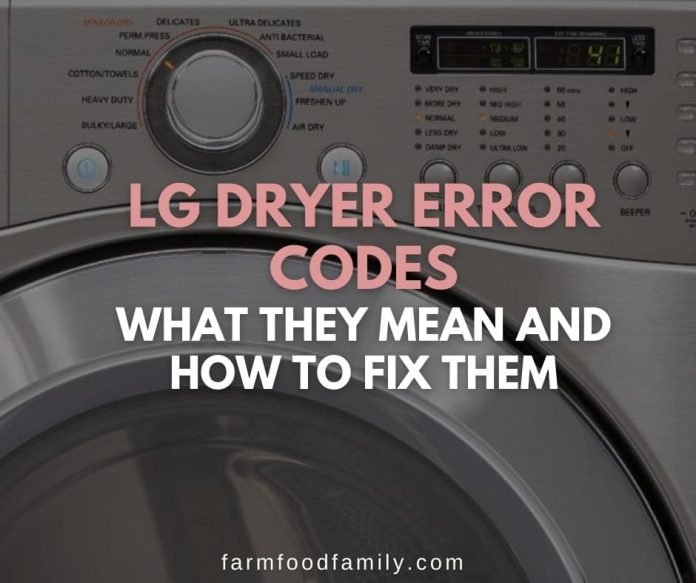
Understanding your dryer is a bit like understanding your car. It has various parts that need to work together efficiently, and just like a car won’t run properly without oil, your dryer needs proper ventilation and a functional heating element to do its job. This error often stems from inadequate airflow or issues with the heating element. But, before you start worrying about repair costs, let’s walk through some simple preventive measures. They’re easier than you might think and can save you both time and money down the road.
Understanding the ‘HE’ Error Code
So, what exactly does the “HE” error code mean? Well, picture your dryer as a mini version of a weather system. It needs heat and airflow to function correctly. The “HE” code usually appears when the dryer senses that it’s not getting enough heat to dry clothes efficiently. This can happen for a few reasons, much like how a change in wind can alter weather patterns.
First off, clogged lint filters or vents might restrict the airflow. It’s like trying to breathe through a straw while you’re running; it just doesn’t work well. The dryer’s heating element needs unobstructed airflow to operate efficiently, and any blockages can cause the dryer to overheat or not heat at all. This is one of the most common causes and, thankfully, one of the simplest to fix.
Another reason might be a malfunction in the heating element itself. Think of it like a broken heater in your home. If it’s not working, you’re not getting warm. The heating element can wear out over time due to constant use, leading it to fail and cause this error code. Regular maintenance checks can prolong its life and help avoid unexpected breakdowns.
Lastly, a faulty thermostat or sensor can lead to the “HE” error. The dryer relies on these components to regulate and monitor temperature. If they’re not functioning correctly, it’s like having a faulty thermostat in your house — your dryer might not know when or how to heat properly.
The Importance of Regular Maintenance
Now, you might be wondering, “How do I stop this from happening altogether?” The key lies in maintenance. Just like with cars or any other appliance, regular maintenance checks can prevent most issues from arising. It’s kind of like going to the doctor for a yearly check-up to ensure everything’s working as it should.
Start by cleaning your lint filter after every cycle. This might seem trivial, but a clean filter allows air to circulate freely, which is crucial for the dryer to function. Imagine trying to talk with a mouthful of food; that’s what it’s like for your dryer when the vent is clogged. This small step can have a big impact on performance.
Next, consider the dryer vent. It’s not just the inside of your dryer that needs attention; the vent leading outside can also get blocked. A clogged vent can cause overheating, leading to the dreaded “HE” error. Once a month, disconnect the vent to check for and remove any lint buildup. It’s a small effort with a big payoff.
Also, keep an eye on the condition of the dryer’s components. Periodically inspect the heating element and thermostat. If you notice signs of wear or damage, like a heating element that isn’t glowing red or a thermostat that causes erratic temperature changes, it might be time to replace these parts. Doing so can prevent issues before they start.
Professional Help vs. DIY Fixes
At this point, you might be asking yourself, “Can I handle this on my own, or do I need an expert?” Well, it depends on your comfort level and technical skills. There are plenty of resources and guides available for those who feel confident taking a DIY approach. For instance, cleaning vents and inspecting filters are straightforward tasks that most people can handle with a few basic tools.
However, when it comes to replacing components like heating elements or thermostats, you might want to consider calling a professional. Much like how you wouldn’t perform surgery based on a YouTube tutorial, complex dryer repairs can benefit from expert hands. Professionals are equipped with the right tools and knowledge to diagnose and fix issues accurately, saving you the hassle and potential mishaps.
But don’t feel discouraged if you prefer leaving the technical stuff to others. Even by just doing simple maintenance like cleaning and checking, you’re already doing a lot to prevent future issues. Plus, knowing when to call in a pro is an important part of maintaining your dryer’s health.
Looking Ahead: Future-Proofing Your Dryer
So, how do we ensure that our beloved LG dryer continues to serve us well into the future? Much like keeping a pet happy and healthy, it’s about consistent care and attention. Being proactive rather than reactive is key. Regularly checking and cleaning the dryer might seem tedious, but it’s a small price to pay for the benefit of a smoothly running machine.
As a final tip, always read and follow the manufacturer’s guidelines. It’s like having the ultimate insider’s guide to your appliance. These guidelines often include maintenance tips and troubleshooting steps which are invaluable in preventing issues like the “HE” error code. They’re a bit like a secret recipe — once you know it, you’re set for success.
In conclusion, preventing the “HE” error in your LG dryer isn’t rocket science. With regular maintenance, a bit of DIY spirit, and knowing when to call in the experts, you can keep your dryer running smoothly. Remember, it’s all about keeping those components in check and ensuring nothing gets in the way of efficient airflow and heating. Here’s to many more years of dry, fluffy laundry and worry-free drying cycles!